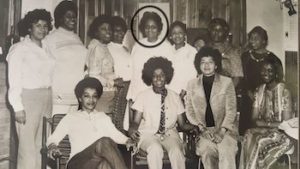
Mattiedna Johnson (Back Row Center)
*Mattiedna Johnson was born on this date in 1918. She was a Black nurse and laboratory technician. Mattiedna Johnson was born to sharecroppers in Mississippi. She weighed three and a half pounds at birth and was the fifth child born in her family. With concern about his daughter's low birth weight, Johnson's father pleaded to God to provide her with a healthy life in exchange for her living to serve. Her father drove Johnson to pursue a career in health care. His goal for her was to be a medical missionary in Africa. Johnson grew up with a mother who did not like girls and a father who called her Tots. She published a biography later in her life called Tots Goes to Gbarnga.
Personal life
She got divorced after 36 years of marriage. In 1959, she moved to Cleveland, Ohio, after visiting as a missionary to save troubled churches around the United States. In Cleveland, Johnson worked as a nurse and wrote about her discrimination. She was a part of the American Nurses Association throughout her nursing career. Johnson stated she was denied registration for the Private Duty Registry at the 1961 Ohio Nurses Association convention. She presented a speech about the racism she faces as a Black nurse in Ohio. Johnson also served as a medical missionary in Liberia and Africa and advocated for the Liberian National Nursing Association. While in Africa, she taught courses at the College of West Africa. In a continued effort to support Black nurses, Johnson became an active member of the Congressional Black Caucus Health Braintrust and Ohio's 21st Congressional District Caucus.
Education
Johnson received her first degree from Jane Terrell Memorial Hospital School of Nursing in Memphis, Tennessee. She received her Registered Nurse License at the Homer G. Phillips Hospital in St. Louis, Missouri. In 1945, she completed a medical technology program at the Northwest Institute of Medical Technology in Minneapolis, Minnesota. She received an American Red Cross certificate for teaching first aid and disaster nursing. Johnson also became certified as a medical missionary.
Contributions Penicillin and Scarlet Fever
After completing the medical technology program, Johnson joined the University of Minnesota's Plant Pathology Department as a lab technician working on penicillin research. Johnson's childhood provided her with a particular advantage in this field of work, as her research often entailed isolating molds from various foods, especially vegetables. The same techniques used to make things like butter, jams, and soap on her childhood farm gave her the insight to develop methods to capture and preserve molds for research purposes. Johnson worked with a variety of vegetables during her time on this project.
Still, a bowl of tomato soup provided by a department employee finally yielded results. After isolating the mold from the soup, Johnson tested the strain against the bacteria known to cause scarlet fever. The results of her experiment were promising, as the mold was particularly effective at killing the bacteria. She described the mold spores as 'terrible mice' and showed the mold to John Ehrlich, a colleague working on the project.
She told him of the mold's effectiveness against scarlet fever and suggested that the medicine be mixed with peppermint syrup to be tastier for children. Ehrlich put the samples in his pocket, but Johnson never heard anything about her discovery after that. Years later, the antibiotic Terramycin was introduced, and Johnson believed it was created from her "terrible mice" mold. Her recommendation of adding peppermint syrup for taste led to the creation of Terramycin syrup. Pfizer developed and sold Terramycin, and the sales of this medication rose to $45 million. Pfizer agrees that Johnson was a part of the Penicillin Project. However, Johnson was never compensated for her work in medicine. On October 23, 1990, she was honored in a speech to the House of Representatives for her accomplishments.
Contributions to the National Black Nurses Association
In 1970, nurses from around the nation gathered in Miami, Florida, for the 47th American Nurses Association convention (ANA) convention. While attending, Johnson was concerned with the lack of representation for Black nurses. To discuss these matters, she hosted a meeting for Black nurses where they addressed the issues of underrepresentation and other problems in Black health care. She wanted to continue the conversation, so in 1971, Johnson and 11 other Black nurses founded the National Black Nurses Association (NBNA). At this first meeting, Johnson was appointed as Secretary. She further created the Cleveland Council of Black Nurses in 1973.
Contributions to Blood Pressure Screenings Johnson and some of her fellow nurses did a 575-person blood pressure screening after noticing the number of funerals their church was having. The screening was done at Cory United Methodist Church. It led to blood pressure screenings becoming widespread as it was the first time they were done outside of a hospital. Johnson later became involved in the International Society on Hypertension in Blacks (ISHIB). She authored The Penicillin Project Dairy Notes and Tots Goes to Gbarnga using her father's nickname. Mattiedna Johnson died in December 2003. She died at the age of 85.